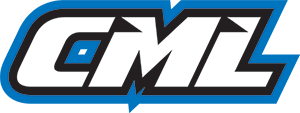TC6 Build Tips

Team Associated Captain Olly Jefferies was the first person in the UK to get some real track experience using the new TC6. In this report he shares his findings...
Hi, and welcome to my Team Associated TC6 touring car build tips. The car should be built as per the manual but here are a few pointers that will help get the most from your new TC6.
So, let?s start off with fitting the servo as this is a part that can be done quickly but is something that needs to be done properly. It?s very easy to twist any car from fitting the servo badly. I always use a thin piece of header card to sit under the servo while fitting; this keeps the servo off the chassis slightly. I tighten each screw but not fully. This lines the servo posts up straight before tightening fully. Make sure the car is flat then tighten all screws starting with the screws in chassis first, then the four servo mount screws corner to corner. Once tight remove the header card, place on a board to double check car is flat.
 Use a thin piece of card under the servo while mounting.
Following on with steering we move to the steering hubs. This can look simple and can be completed very quickly but is something that is crucial when putting the car together. I have a few things I do when building this part to ensure everything moves smoothly. I always put a screw into any plastic part before screwing it onto the car. If you put together the hub and castor block then try and screw into this it?s unlikely it will be straight, it?s much easier to see the screw and line it up while it?s not fitted into the castor block. You will find if the screw thread is straight the steering hub will move without any friction. This will help the car run straight and you will be able to get the most from a fast servo. If the steering is tight the car will struggle to run straight. When fitting the ball joints make sure everything can move freely, if needed I use a pair of pliers to squeeze the ball joint slightly to help loosen up the ball joint.
Use a thin piece of card under the servo while mounting.
Following on with steering we move to the steering hubs. This can look simple and can be completed very quickly but is something that is crucial when putting the car together. I have a few things I do when building this part to ensure everything moves smoothly. I always put a screw into any plastic part before screwing it onto the car. If you put together the hub and castor block then try and screw into this it?s unlikely it will be straight, it?s much easier to see the screw and line it up while it?s not fitted into the castor block. You will find if the screw thread is straight the steering hub will move without any friction. This will help the car run straight and you will be able to get the most from a fast servo. If the steering is tight the car will struggle to run straight. When fitting the ball joints make sure everything can move freely, if needed I use a pair of pliers to squeeze the ball joint slightly to help loosen up the ball joint.
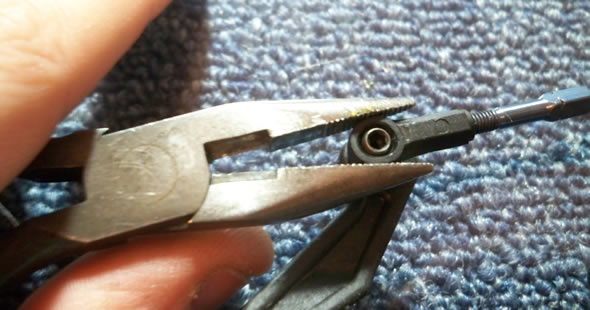 Loosen the ball joint with a pair of pliers.
Another tip while building the hubs is to score the inside were the bearing sits. This gives a tighter fit for the bearing. When a hub is new this is not needed but rather than change parts when they are worn or when slop start to appear you can do this and it will remove any slop in the bearing fitting.
Loosen the ball joint with a pair of pliers.
Another tip while building the hubs is to score the inside were the bearing sits. This gives a tighter fit for the bearing. When a hub is new this is not needed but rather than change parts when they are worn or when slop start to appear you can do this and it will remove any slop in the bearing fitting.
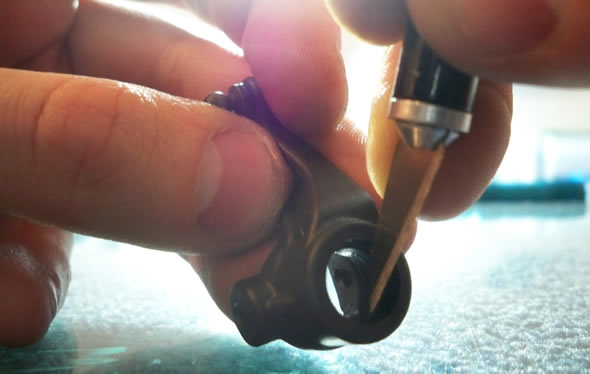 Increase the life of the bearing hubs by scoring the inside.
So moving onto the front spool. The TC6 comes with a slipper spool, which is built in the same way as the TC5. For this time of year with everyone racing indoors on small tracks this is ideal, it saves braking drive shafts and blades as it can slip slightly during a crash. On a big tracks where this is less likely you can build it without any slip. I glue some 800 grit wet 'n' dry to each side of the slipper pads. This gives the pad extra grip and removes the slipper spool action. Be careful when fitting the spool back into the car as certain wet 'n' dry can be thicker than others so it can make the spool slightly wider. You can remove the small silver shim from each side of the spool to allow for this, make sure the diff spins freely once fitted.
Increase the life of the bearing hubs by scoring the inside.
So moving onto the front spool. The TC6 comes with a slipper spool, which is built in the same way as the TC5. For this time of year with everyone racing indoors on small tracks this is ideal, it saves braking drive shafts and blades as it can slip slightly during a crash. On a big tracks where this is less likely you can build it without any slip. I glue some 800 grit wet 'n' dry to each side of the slipper pads. This gives the pad extra grip and removes the slipper spool action. Be careful when fitting the spool back into the car as certain wet 'n' dry can be thicker than others so it can make the spool slightly wider. You can remove the small silver shim from each side of the spool to allow for this, make sure the diff spins freely once fitted.
 Even the best drivers can have days filled with crashes. Wet 'n' dry helps Olly keep his bad days down.
Once the spool is fitted you now need to set the belt tension, which is very important. When checking this you need to make sure the top deck is tightened down. If the top deck is loose you will not able to set the belt accurately as without the top deck the car will 'banana' slightly from the belts. If set when top deck is loose when you come to tighten the top deck the belt will be much tighter. This is the same for setting up the rear belt. I always set my front belt tighter than the rear as it?s longer.
Even the best drivers can have days filled with crashes. Wet 'n' dry helps Olly keep his bad days down.
Once the spool is fitted you now need to set the belt tension, which is very important. When checking this you need to make sure the top deck is tightened down. If the top deck is loose you will not able to set the belt accurately as without the top deck the car will 'banana' slightly from the belts. If set when top deck is loose when you come to tighten the top deck the belt will be much tighter. This is the same for setting up the rear belt. I always set my front belt tighter than the rear as it?s longer.
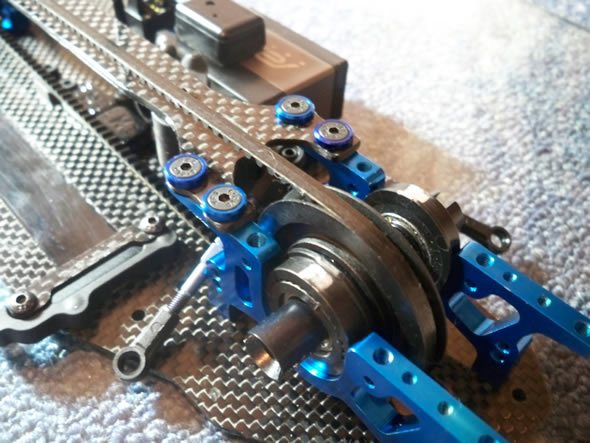 A tighter belt usually equals a tighter performance.
With current on-road cars it?s more important than ever that the chassis is flat. This means taking extra care when fitting the motor mount and bulkheads. I build my car on a piece of glass and I fit one part at a time. I then check car is flat before fitting next part. This is the best way, as when the car is built it will take much longer trying to find which part is causing the tweak. Parts can be damaged in crashes so it?s much easier when you're building the car to find any parts that might need changing by fitting one part at a time. This obviously takes a bit longer but it saves time later in the build. With the motor mount I tighten the screws but not fully tight. Once I have checked the car is flat I then finally tighten them fully. I do the same with the countersunk screws in chassis. While tightening the motor mount its worth applying some pressure onto the chassis to help keep it flat and stop the car moving around, I do the same when fitting the top deck.
A tighter belt usually equals a tighter performance.
With current on-road cars it?s more important than ever that the chassis is flat. This means taking extra care when fitting the motor mount and bulkheads. I build my car on a piece of glass and I fit one part at a time. I then check car is flat before fitting next part. This is the best way, as when the car is built it will take much longer trying to find which part is causing the tweak. Parts can be damaged in crashes so it?s much easier when you're building the car to find any parts that might need changing by fitting one part at a time. This obviously takes a bit longer but it saves time later in the build. With the motor mount I tighten the screws but not fully tight. Once I have checked the car is flat I then finally tighten them fully. I do the same with the countersunk screws in chassis. While tightening the motor mount its worth applying some pressure onto the chassis to help keep it flat and stop the car moving around, I do the same when fitting the top deck.
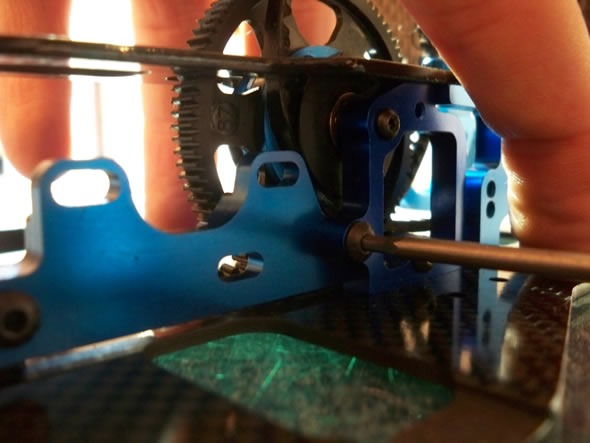 Apply pressure to the chassis to prevent the motor mount moving.
Onto the shocks. The TC6 features the new VS3 shocks. This is big improvement from the TC5, the shocks build much better and the car now has much more up travel. This helps the car ride bumps and curbs. I try to spend lots of time when building shocks as they need to be as equal as possible. I use a Ride Shock Pump, which makes life much easier. Starting off with the o-rings, I always cover them in shock oil before fitting. It?s worth double-checking all the plastic parts before building just to check there no excess plastic. I let the o-ring sit in the oil while I am working on the other parts. I load the bottom of the shock but do not tighten fully. Once the shock shaft is in the shock I then tighten the bottom shock cap. I find this is the best way to make sure every is lined up correctly as the shock shaft will hold everything straight. Just go through each shock before filling to make sure everything is moving smoothly. Once I have filled with oil and removed the air from the shock with the shock pump its time to set the rebound. Rebound makes a big difference to the handling of the car. I set the shock shaft to the amount of rebound I want before fitting the diaphragm. For example, if I wanted 50% rebound I would push the shock shaft in half way. Then fit the diaphragm and then the screw the top on while keeping the shock shaft in same place. You might find this takes a couple of attempts to get the hang of it. You might also find that when the shock shaft is pulled out it can sometimes contract back in a little. This is normal as it?s the diaphragm pulling the shaft back up and is nothing to worry about.
Apply pressure to the chassis to prevent the motor mount moving.
Onto the shocks. The TC6 features the new VS3 shocks. This is big improvement from the TC5, the shocks build much better and the car now has much more up travel. This helps the car ride bumps and curbs. I try to spend lots of time when building shocks as they need to be as equal as possible. I use a Ride Shock Pump, which makes life much easier. Starting off with the o-rings, I always cover them in shock oil before fitting. It?s worth double-checking all the plastic parts before building just to check there no excess plastic. I let the o-ring sit in the oil while I am working on the other parts. I load the bottom of the shock but do not tighten fully. Once the shock shaft is in the shock I then tighten the bottom shock cap. I find this is the best way to make sure every is lined up correctly as the shock shaft will hold everything straight. Just go through each shock before filling to make sure everything is moving smoothly. Once I have filled with oil and removed the air from the shock with the shock pump its time to set the rebound. Rebound makes a big difference to the handling of the car. I set the shock shaft to the amount of rebound I want before fitting the diaphragm. For example, if I wanted 50% rebound I would push the shock shaft in half way. Then fit the diaphragm and then the screw the top on while keeping the shock shaft in same place. You might find this takes a couple of attempts to get the hang of it. You might also find that when the shock shaft is pulled out it can sometimes contract back in a little. This is normal as it?s the diaphragm pulling the shaft back up and is nothing to worry about.
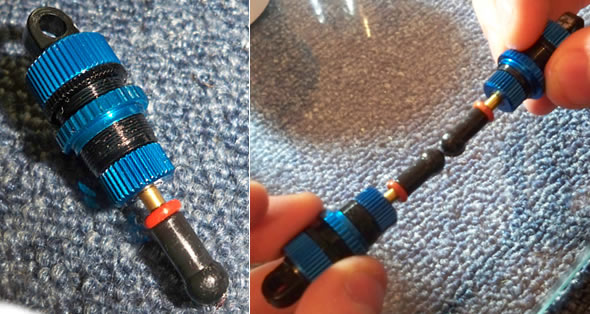 A 50% rebound shock(left).Always make sure the shock are the same length (right).
Before fitting the shocks you need to set droop. Make sure the droop is set before fitting the shocks. The shocks can put pressure on the suspension arm, which then makes it difficult to set the droop accurately. I always set droop without shocks fitted.
So before running the car we need to set ride height and tweak. Ride height is pretty simple to set. I find on the UK tracks I run around 5.5mm to 6mm. To check my ride height on track I mark the chassis with a silver pen in each corner. After the run you can see if any has be worn away. Then you can set ride height accordingly. I try to run the car as low as possible but without the chassis hitting the floor. To set ride height accurately you need to make sure the car is balanced left to right. The TC6 has a great balance and with most radio gear will balance out the box, if not try to move the radio gear slightly or apply lead weight.
A 50% rebound shock(left).Always make sure the shock are the same length (right).
Before fitting the shocks you need to set droop. Make sure the droop is set before fitting the shocks. The shocks can put pressure on the suspension arm, which then makes it difficult to set the droop accurately. I always set droop without shocks fitted.
So before running the car we need to set ride height and tweak. Ride height is pretty simple to set. I find on the UK tracks I run around 5.5mm to 6mm. To check my ride height on track I mark the chassis with a silver pen in each corner. After the run you can see if any has be worn away. Then you can set ride height accordingly. I try to run the car as low as possible but without the chassis hitting the floor. To set ride height accurately you need to make sure the car is balanced left to right. The TC6 has a great balance and with most radio gear will balance out the box, if not try to move the radio gear slightly or apply lead weight.
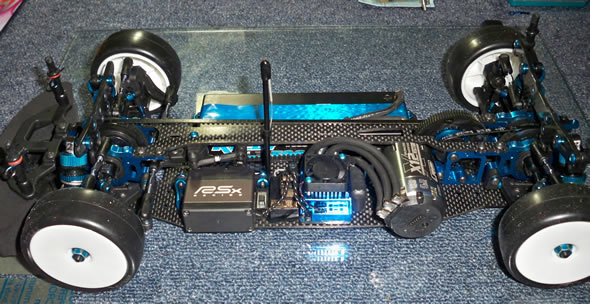 Having a balanced car is vital to success.
I run around 20g to 30g on my car depending on tyres so it?s easy to achieve perfect balance, a decent ride height tool is a good investment for the pit box. So once the ride height is set we now check the tweak of the car. I do this by hanging one end of the car off the set up board. I then lift the chassis up using the small holes underneath and bring it down onto the edge of the board. You will see that if the car is tweaked once side of the chassis will touch down before the other. To fix this adjust the collar on the opposite corner of the car slightly to get the car to touchdown flat. In an ideal world you don't want to have to make big adjustments to shock collars. If you find your having to make big adjustments then it?s worth checking over the shocks and making sure when the wheels are off the car sits flat on the board.
Olly Jefferies
Having a balanced car is vital to success.
I run around 20g to 30g on my car depending on tyres so it?s easy to achieve perfect balance, a decent ride height tool is a good investment for the pit box. So once the ride height is set we now check the tweak of the car. I do this by hanging one end of the car off the set up board. I then lift the chassis up using the small holes underneath and bring it down onto the edge of the board. You will see that if the car is tweaked once side of the chassis will touch down before the other. To fix this adjust the collar on the opposite corner of the car slightly to get the car to touchdown flat. In an ideal world you don't want to have to make big adjustments to shock collars. If you find your having to make big adjustments then it?s worth checking over the shocks and making sure when the wheels are off the car sits flat on the board.
Olly Jefferies
 Use a thin piece of card under the servo while mounting.
Following on with steering we move to the steering hubs. This can look simple and can be completed very quickly but is something that is crucial when putting the car together. I have a few things I do when building this part to ensure everything moves smoothly. I always put a screw into any plastic part before screwing it onto the car. If you put together the hub and castor block then try and screw into this it?s unlikely it will be straight, it?s much easier to see the screw and line it up while it?s not fitted into the castor block. You will find if the screw thread is straight the steering hub will move without any friction. This will help the car run straight and you will be able to get the most from a fast servo. If the steering is tight the car will struggle to run straight. When fitting the ball joints make sure everything can move freely, if needed I use a pair of pliers to squeeze the ball joint slightly to help loosen up the ball joint.
Use a thin piece of card under the servo while mounting.
Following on with steering we move to the steering hubs. This can look simple and can be completed very quickly but is something that is crucial when putting the car together. I have a few things I do when building this part to ensure everything moves smoothly. I always put a screw into any plastic part before screwing it onto the car. If you put together the hub and castor block then try and screw into this it?s unlikely it will be straight, it?s much easier to see the screw and line it up while it?s not fitted into the castor block. You will find if the screw thread is straight the steering hub will move without any friction. This will help the car run straight and you will be able to get the most from a fast servo. If the steering is tight the car will struggle to run straight. When fitting the ball joints make sure everything can move freely, if needed I use a pair of pliers to squeeze the ball joint slightly to help loosen up the ball joint.
 Loosen the ball joint with a pair of pliers.
Another tip while building the hubs is to score the inside were the bearing sits. This gives a tighter fit for the bearing. When a hub is new this is not needed but rather than change parts when they are worn or when slop start to appear you can do this and it will remove any slop in the bearing fitting.
Loosen the ball joint with a pair of pliers.
Another tip while building the hubs is to score the inside were the bearing sits. This gives a tighter fit for the bearing. When a hub is new this is not needed but rather than change parts when they are worn or when slop start to appear you can do this and it will remove any slop in the bearing fitting.
 Increase the life of the bearing hubs by scoring the inside.
So moving onto the front spool. The TC6 comes with a slipper spool, which is built in the same way as the TC5. For this time of year with everyone racing indoors on small tracks this is ideal, it saves braking drive shafts and blades as it can slip slightly during a crash. On a big tracks where this is less likely you can build it without any slip. I glue some 800 grit wet 'n' dry to each side of the slipper pads. This gives the pad extra grip and removes the slipper spool action. Be careful when fitting the spool back into the car as certain wet 'n' dry can be thicker than others so it can make the spool slightly wider. You can remove the small silver shim from each side of the spool to allow for this, make sure the diff spins freely once fitted.
Increase the life of the bearing hubs by scoring the inside.
So moving onto the front spool. The TC6 comes with a slipper spool, which is built in the same way as the TC5. For this time of year with everyone racing indoors on small tracks this is ideal, it saves braking drive shafts and blades as it can slip slightly during a crash. On a big tracks where this is less likely you can build it without any slip. I glue some 800 grit wet 'n' dry to each side of the slipper pads. This gives the pad extra grip and removes the slipper spool action. Be careful when fitting the spool back into the car as certain wet 'n' dry can be thicker than others so it can make the spool slightly wider. You can remove the small silver shim from each side of the spool to allow for this, make sure the diff spins freely once fitted.
 Even the best drivers can have days filled with crashes. Wet 'n' dry helps Olly keep his bad days down.
Once the spool is fitted you now need to set the belt tension, which is very important. When checking this you need to make sure the top deck is tightened down. If the top deck is loose you will not able to set the belt accurately as without the top deck the car will 'banana' slightly from the belts. If set when top deck is loose when you come to tighten the top deck the belt will be much tighter. This is the same for setting up the rear belt. I always set my front belt tighter than the rear as it?s longer.
Even the best drivers can have days filled with crashes. Wet 'n' dry helps Olly keep his bad days down.
Once the spool is fitted you now need to set the belt tension, which is very important. When checking this you need to make sure the top deck is tightened down. If the top deck is loose you will not able to set the belt accurately as without the top deck the car will 'banana' slightly from the belts. If set when top deck is loose when you come to tighten the top deck the belt will be much tighter. This is the same for setting up the rear belt. I always set my front belt tighter than the rear as it?s longer.
 A tighter belt usually equals a tighter performance.
With current on-road cars it?s more important than ever that the chassis is flat. This means taking extra care when fitting the motor mount and bulkheads. I build my car on a piece of glass and I fit one part at a time. I then check car is flat before fitting next part. This is the best way, as when the car is built it will take much longer trying to find which part is causing the tweak. Parts can be damaged in crashes so it?s much easier when you're building the car to find any parts that might need changing by fitting one part at a time. This obviously takes a bit longer but it saves time later in the build. With the motor mount I tighten the screws but not fully tight. Once I have checked the car is flat I then finally tighten them fully. I do the same with the countersunk screws in chassis. While tightening the motor mount its worth applying some pressure onto the chassis to help keep it flat and stop the car moving around, I do the same when fitting the top deck.
A tighter belt usually equals a tighter performance.
With current on-road cars it?s more important than ever that the chassis is flat. This means taking extra care when fitting the motor mount and bulkheads. I build my car on a piece of glass and I fit one part at a time. I then check car is flat before fitting next part. This is the best way, as when the car is built it will take much longer trying to find which part is causing the tweak. Parts can be damaged in crashes so it?s much easier when you're building the car to find any parts that might need changing by fitting one part at a time. This obviously takes a bit longer but it saves time later in the build. With the motor mount I tighten the screws but not fully tight. Once I have checked the car is flat I then finally tighten them fully. I do the same with the countersunk screws in chassis. While tightening the motor mount its worth applying some pressure onto the chassis to help keep it flat and stop the car moving around, I do the same when fitting the top deck.
 Apply pressure to the chassis to prevent the motor mount moving.
Onto the shocks. The TC6 features the new VS3 shocks. This is big improvement from the TC5, the shocks build much better and the car now has much more up travel. This helps the car ride bumps and curbs. I try to spend lots of time when building shocks as they need to be as equal as possible. I use a Ride Shock Pump, which makes life much easier. Starting off with the o-rings, I always cover them in shock oil before fitting. It?s worth double-checking all the plastic parts before building just to check there no excess plastic. I let the o-ring sit in the oil while I am working on the other parts. I load the bottom of the shock but do not tighten fully. Once the shock shaft is in the shock I then tighten the bottom shock cap. I find this is the best way to make sure every is lined up correctly as the shock shaft will hold everything straight. Just go through each shock before filling to make sure everything is moving smoothly. Once I have filled with oil and removed the air from the shock with the shock pump its time to set the rebound. Rebound makes a big difference to the handling of the car. I set the shock shaft to the amount of rebound I want before fitting the diaphragm. For example, if I wanted 50% rebound I would push the shock shaft in half way. Then fit the diaphragm and then the screw the top on while keeping the shock shaft in same place. You might find this takes a couple of attempts to get the hang of it. You might also find that when the shock shaft is pulled out it can sometimes contract back in a little. This is normal as it?s the diaphragm pulling the shaft back up and is nothing to worry about.
Apply pressure to the chassis to prevent the motor mount moving.
Onto the shocks. The TC6 features the new VS3 shocks. This is big improvement from the TC5, the shocks build much better and the car now has much more up travel. This helps the car ride bumps and curbs. I try to spend lots of time when building shocks as they need to be as equal as possible. I use a Ride Shock Pump, which makes life much easier. Starting off with the o-rings, I always cover them in shock oil before fitting. It?s worth double-checking all the plastic parts before building just to check there no excess plastic. I let the o-ring sit in the oil while I am working on the other parts. I load the bottom of the shock but do not tighten fully. Once the shock shaft is in the shock I then tighten the bottom shock cap. I find this is the best way to make sure every is lined up correctly as the shock shaft will hold everything straight. Just go through each shock before filling to make sure everything is moving smoothly. Once I have filled with oil and removed the air from the shock with the shock pump its time to set the rebound. Rebound makes a big difference to the handling of the car. I set the shock shaft to the amount of rebound I want before fitting the diaphragm. For example, if I wanted 50% rebound I would push the shock shaft in half way. Then fit the diaphragm and then the screw the top on while keeping the shock shaft in same place. You might find this takes a couple of attempts to get the hang of it. You might also find that when the shock shaft is pulled out it can sometimes contract back in a little. This is normal as it?s the diaphragm pulling the shaft back up and is nothing to worry about.
 A 50% rebound shock(left).Always make sure the shock are the same length (right).
Before fitting the shocks you need to set droop. Make sure the droop is set before fitting the shocks. The shocks can put pressure on the suspension arm, which then makes it difficult to set the droop accurately. I always set droop without shocks fitted.
So before running the car we need to set ride height and tweak. Ride height is pretty simple to set. I find on the UK tracks I run around 5.5mm to 6mm. To check my ride height on track I mark the chassis with a silver pen in each corner. After the run you can see if any has be worn away. Then you can set ride height accordingly. I try to run the car as low as possible but without the chassis hitting the floor. To set ride height accurately you need to make sure the car is balanced left to right. The TC6 has a great balance and with most radio gear will balance out the box, if not try to move the radio gear slightly or apply lead weight.
A 50% rebound shock(left).Always make sure the shock are the same length (right).
Before fitting the shocks you need to set droop. Make sure the droop is set before fitting the shocks. The shocks can put pressure on the suspension arm, which then makes it difficult to set the droop accurately. I always set droop without shocks fitted.
So before running the car we need to set ride height and tweak. Ride height is pretty simple to set. I find on the UK tracks I run around 5.5mm to 6mm. To check my ride height on track I mark the chassis with a silver pen in each corner. After the run you can see if any has be worn away. Then you can set ride height accordingly. I try to run the car as low as possible but without the chassis hitting the floor. To set ride height accurately you need to make sure the car is balanced left to right. The TC6 has a great balance and with most radio gear will balance out the box, if not try to move the radio gear slightly or apply lead weight.
 Having a balanced car is vital to success.
I run around 20g to 30g on my car depending on tyres so it?s easy to achieve perfect balance, a decent ride height tool is a good investment for the pit box. So once the ride height is set we now check the tweak of the car. I do this by hanging one end of the car off the set up board. I then lift the chassis up using the small holes underneath and bring it down onto the edge of the board. You will see that if the car is tweaked once side of the chassis will touch down before the other. To fix this adjust the collar on the opposite corner of the car slightly to get the car to touchdown flat. In an ideal world you don't want to have to make big adjustments to shock collars. If you find your having to make big adjustments then it?s worth checking over the shocks and making sure when the wheels are off the car sits flat on the board.
Olly Jefferies
Having a balanced car is vital to success.
I run around 20g to 30g on my car depending on tyres so it?s easy to achieve perfect balance, a decent ride height tool is a good investment for the pit box. So once the ride height is set we now check the tweak of the car. I do this by hanging one end of the car off the set up board. I then lift the chassis up using the small holes underneath and bring it down onto the edge of the board. You will see that if the car is tweaked once side of the chassis will touch down before the other. To fix this adjust the collar on the opposite corner of the car slightly to get the car to touchdown flat. In an ideal world you don't want to have to make big adjustments to shock collars. If you find your having to make big adjustments then it?s worth checking over the shocks and making sure when the wheels are off the car sits flat on the board.
Olly Jefferies


